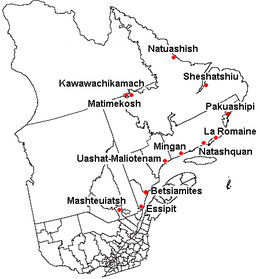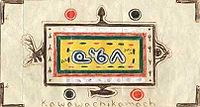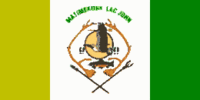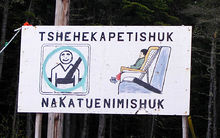- Innu people
-
Innu
Flag of the Innu Nation of Quebec and Labrador
Flag of the Kawawachikamach Band of the Naskapi Nation
Flag of the Matimekush Band of the Innu-Montagnais Nation
Total population 18,000 Regions with significant populations Canada (Quebec, Labrador) Languages Religion Christianity, other
Related ethnic groups  Innu communities of Quebec and Labrador and the two Naskapi communities (Kawawachikamach and Natuashish)
Innu communities of Quebec and Labrador and the two Naskapi communities (Kawawachikamach and Natuashish)
The Innu are the indigenous inhabitants of an area they refer to as Nitassinan (“Our Land”), which comprises most of the northeastern portions of the provinces of Quebec and some western portions of Labrador. Their population in 2003 includes about 18,000 people, of which 15,000 live in Quebec and under 3000 in Labrador.
Their ancestors were known to have lived on these lands as hunter-gatherers for several thousand years, living in tents made of animal skins. Their subsistence activities were historically centred on hunting and trapping caribou, moose, deer and small game. Some coastal clans also practised agriculture, fished, and managed maple sugarbush.
Their language, Innu-aimun or Ilnu (populary known as Montagnais),[1] is spoken throughout Nitassinan, with certain dialect differences. Innu-aimun is related to East Cree (Īyiyū Ayimūn - Northern/Coastal dialect and Īnū Ayimūn - Southern/Inland dialect) spoken by the James Bay Cree of the James Bay region of Quebec and Ontario and the Atikamekw (Nēhinawēwin and Nehirâmowin) of the Atikamekw (‘Nehiraw’, ‘Nehirowisiw’). Innu-aimun is divided into four dialects - Southern Montagnais (Mashteuiatsh and Betsiamites), Eastern Montagnais (Mingan, Natashquan, La Romaine, Pakuashipi), Central Montagnais (Sept-Iles and Maliotenam, Matimekosh) and Labrador -Montagnais (Sheshatshit).[2] The speakers of the different dialects can communicate well with each other. The Naskapi language and culture are quite different from those of the Montagnais,[3] in which the dialect changes from y to n as in "Iiyuu" versus "Innu".
The Innu were allied with neighboring Atikamekw, Maliseet (also known as Malecite) and Algonquin against their traditional enemies, the Mi'kmaq (formerly known as Micmac) and Iroquois (also known as the Haudenosaunee). During the Beaver Wars (1640 - 1701) the Iroquois repeatedly invaded their territories, and enslaved women and warriors, as well plundering their hunting grounds in search of more furs. Since these raids were made by the Iroquois with unprecedented brutality, the Innu themselves now took over the torment and torture and the cruelty of their Indian enemies. The Naskapi on the other hand were usually in conflicts with the advancing southward Inuit in the east.
Contents
Montagnais, Naskapi or Innu
The Innu people are frequently categorized into two groups, the Montagnais (French: “mountain people”, speak: Moon-tahn-YAY) or Innu proper (Nehilaw and Ilniw - “people”), who live along the north shore of the Gulf of Saint Lawrence, in Quebec; and the less numerous Naskapi (Innu and Iyiyiw), who live farther north. The Innu recognize several distinctions (e.g. Mushuau Innuat, Maskuanu, Uashau Innuat) based on different regional affiliations and various dialects of the Innu language.
The word Naskapi (meaning "people beyond the horizon") first was recorded by French colonists in the 17th century and was subsequently applied to Innu groups beyond the reach of missionary influence. It particularly applied to those living in the lands which bordered Ungava Bay and the northern Labrador coast, near the Inuit communities of northern Quebec and northern Labrador. It is here that the term came to be used for the Naskapi First Nation.
The Naskapi are traditionally nomadic peoples, in contrast with the more sedentary Montagnais, who establish settled territories. Mushuau Innuat (plural), while related to the Naskapi, split off from the tribe in the 1900s. They were subject to a government relocation program at Davis Inlet. Some of the families of the Naskapi Nation of Kawawachikamach have close relatives in the Cree village of Whapmagoostui, on the eastern shore of Hudson Bay.
Since 1990, the Montagnais people have generally chosen to be officially referred to as the Innu, which means human being in Innu-aimun, while the Naskapi have continued to use the word Naskapi.
The Innu should not be confused with the Inuit, a distinct people who live in the Canadian Arctic. Although their languages vary in origin, the word derives from the same root, meaning "people".
History
Samuel de Champlain befriended members of this group who insisted that he help them in their conflict with the Iroquois, who were ranging north from their traditional territory in present-day New York state. On July 29, 1609, at Ticonderoga or Crown Point, New York, (historians are not sure which of these two places), Champlain and his party encountered a group of Iroquois. A battle began the next day. Two hundred Iroquois advanced on Champlain's position as a native guide pointed out the three Iroquois chiefs to the French. Champlain fired his arquebus and killed two of them with one shot. One of his men killed the third. The Iroquois turned and fled. This was to set the tone for French-Iroquois relations for the next 100 years.
The Innu of Labrador and those living on the north shore of the Gulf of Saint-Lawrence in the Canadian Shield region have never officially surrendered their territory to Canada by way of treaty or other agreement. As the forest and mining operations began at the turn of the 20th century, the Innu became increasingly settled in coastal communities and in the interior of Quebec. The Canadian and provincial governments, the Catholic, Moravian, and Anglican churches, all encouraged the Innu to settle in more permanent communities, in the belief that their lives would improve with this adaptation. But, with the social disruption and decline of the Innu people's traditional activities (hunting, trapping, fishing), community life in the permanent settlements often became associated with high levels of alcoholism, substance abuse by children, domestic violence and suicide.
Davis Inlet, Labrador
In 1999 Survival International published a study of the Innu communities of Labrador. It assessed the impact of the Canadian government's relocating the people far from their ancestral lands and preventing their practising their ancient way of life.[4] Survival International considered these policies to be in violation of international law and drew parallels with the treatment of Tibetans by the People's Republic of China. According to the study, from 1990–1997, the Innu community of Davis Inlet had a suicide rate more than twelve times the Canadian average, and well over three times the rate often observed in isolated northern villages.[4]
By 2000, the Innu island community of Davis Inlet asked the Canadian government to assist with a local addiction crisis. At their request, the community was relocated to a nearby mainland site, now known as Natuashish. At the same time, the Canadian government created the Natuashish and Sheshatshiu band councils under the Indian Act.
Kawawachikamach, Quebec
The Naskapi Nation of Kawawachikamach, of Quebec, is the only Quebec First Nations community that has signed a comprehensive land claims settlement, the Northeastern Quebec Agreement; they did so in 1978. As a consequence, the Naskapi of Kawawachikamach are no longer subject to certain provisions of the Indian Act. All the Innu communities of Quebec are still subject to the Act.
New York Power Authority controversy
The New York Power Authority's proposed contract with the province of Quebec to buy power from its extensive hydroelectric dam facilities has generated controversy.[5] According to the Sierra Club:
[t]he "New York Power Authority is in preliminary discussions and considering the liability of a new contract with Hydro-Québec," a Canadian supplier of hydroelectricity.The Innu community, the Sierra Club, and the National Lawyers Guild are fighting to prevent this proposed contract, which would have to be approved by New York's Governor Paterson under his regulatory authority.[5] The problem is that construction of required electric transmission lines would hinder the Innu's hunting-gathering-fishing lifestyle:
Chief Georges-Ernest Gregoire of the Innu community in Eastern Quebec urged the governor not to proceed with a plan to buy hydroelectric power from Canada, saying the dam complex that would be built would affect the traditional way of life for his people.Chief Gregoire's comments at a press conference in Albany, New York were translated, but whether from French or Innu-aimun is not clear.[5]
Natuashish and Sheshatshiu, Newfoundland and Labrador
Although Innu have been only in Sheshatshiu since fur trading posts were established by the Hudson's Bay Company in Northwest River in the mid-1700s and only in Davis Inlet/Natuashish since the Moravians set up along the Inuit Coast in 1771, Newfoundland and Labrador Premier Danny Williams struck a deal on September 26, 2008, with Labrador's Innu to permit construction of a hydroelectric megaproject to proceed on the proposed Lower Churchill site. They also negotiated compensation for another project on the Upper Churchill, where large tracts of Actual traditional Innu hunting lands were flooded.
Culture
Traditional crafts
Traditional Innu craft is demonstrated in the Innu tea doll. These children's toys originally served a dual purpose for nomadic Innu tribes. When traveling vast distances over challenging terrain, the people left nothing behind. They believed that "Crow" would take it away. Everyone, including young children, helped to transport essential goods. Innu women made intricate dolls from caribou hides and scraps of cloth. They filled the dolls with tea and gave them to young girls to carry on long journeys. The girls could play with the dolls while also carrying important goods. Every able-bodied person carried something. Men generally carried the heavier bags and women would carry young children.
Traditional clothing, style and accessories
Men wore caribou pants and boots with a buckskin long shirt, all made by women. With the introduction of trade cloth from the French and English, people began replacing the buckskin shirts with ones made of cloth. Most still wore boots and pants made from caribou hide. Women wore long dresses of buckskin and moccasins. Contemporary Innu women have often replaced these with manufactured pants and jackets. Women traditionally wore their hair long or in two coils. Men wore theirs long.
Both genders wore necklaces made of bone and bead. Smoke pipes were used by both genders, marked for women as shorter. If a man killed a bear, it was a sign of joy and initiation into adulthood and the man would wear a necklace made from the bear's claws.
Housing
The houses of the Montagnais were cone shaped. The Naskapi made long, domed houses covered in caribou hides. These days the hearth is a metal stove in the centre of the house.
Traditional foods
Animals traditionally eaten included moose, caribou, hare, marten, woodchuck, squirrel; Canada geese, snow geese, brants, ducks, teals, loons, spruce grouse, woodcocks, snipes, passenger pigeons, ptarmigan; whitefish, lake trout, salmon, seal(naskapi) pike, walleye, suckerfish (Catostomidae), sturgeon, catfish, lamprey, and smelt. Fish were eaten roasted or smoke-dried. Moose meat and several types of fish were also smoked. Bannock made from oats, introduced by the French in the 16th century, became a staple. Meat was eaten frozen, raw or roasted, and caribou was sometimes boiled in a stew. Pemmican was made with moose or caribou.
Plants traditionally eaten included raspberries, blueberries, strawberries, cherries, wild grapes, hazelnuts, crab apples, red martagon bulbs, Indian potato, and maple-tree sap for sweetening. Cornmeal was traded for with Iroquois, Algonquin, and Abenaki First Nations peoples, and made into apon (cornbread), which sometimes also included oat or wheat flour when it became available. Pine-needle tea kept away infections and colds resulting from the harsh weather.
Buckskin
Traditionally, buckskin was a most important material used for clothing, boots, moccasins, house covers and storage. Women prepared the hides and many of the products made from it. They scraped the hides to remove all fur, them left them outside to freeze. The next step was to stretch the hide on a frame. They rubbed it with a mixture of animal brain and pine needle tea to soften it. The dampened hide was formed into a ball and left overnight. In the morning, it would be stretched again, then placed over a smoker to smoke and tan it. The hide was left overnight. The finished hide was called buckskin.
Transportation
In traditional Innu communities, people walked or used snow shoes. Today, they still walk and use snow shoes, but when hunting and moving camp, they use snowmobiles.
Innu communities
Labrador Communities
- Natuashish (‘Nat-wah-sheesh’, formerly Davis Inlet (Utshimassits), home of the Mushuau Innu First Nation, Reserve: Natuashish #2, ca. 43 km2, Population: 777) (Naskapi reserve)
- Sheshatshiu (‘Shesh-ah-shee’, Tshishe-shatshu in standardized orthograph, home of the Sheshatshiu Innu First Nation, Reserve: Sheshatshiu #3,ca. 8 km2, Population: 1.368)
Although Sheshatshiu and Natuashish are home to most of the province's Innu people, some also live at Labrador City, Wabush, Happy Valley-Goose Bay, St. John's, and elsewhere.[6]
Labrador Innu Organizations and Land Claims
The Innu people of Labrador formally organized the Naskapi Montagnais Innu Association in 1976 to protect their rights, lands, and way of life against industrialization and other outside forces. The organization changed its name to the Innu Nation in 1990 and functions today as the governing body of the Labrador Innu. The group has won recognition for its members as status Indians under Canada's Indian Act in 2002 and is currently involved in land claim and self-governance negotiations with the federal and provincial governments.[6]
In addition to the Innu Nation, residents at both Natuashish and Sheshatshiu elect Band Councils to represent community concerns. The chiefs of both councils sit on the Innu Nation's board of directors and the three groups work in cooperation with one another.
Quebec Communities
- Betsiamites (Pessamu in standardized orthograph, home of the Bande des Innus de Pessamit, known also as ‘Pessamit Innu Band’, Reserve: Betsiamites,ca. 252 km2, Population: 3.736)
- Ekuantshit (Mingan) (Ekuanitshu in standardized orthograph, home of Les Innus de Ekuanitshit, Reserve: Mingan, ca. 19 km2, Population: 564)
- Essipit (Essipu in standardized orthograph, home of the Innue Essipit, also known as Essipit First Nation or ‘Montagnais Essipit’, Reserve: Innue Essipit (or ‘Communaute Montagnaise Essipit’), ca.88 ha, Population: 437)
- La Nation Innu Matimekush-Lac John (also known as ‘Innu Nation of Matimekush-Lac John’, Reserve: Lac John, Matimekosh #3, ca.94 ha, Population: 850)
- Lac-John
- Matimekosh (Matamekush in standardized orthograph)
- Kawawachikamach (home of the Naskapi Nation of Kawawachikamach, Reserve: Kawawachikamach, ca. 49 km2, Population: 698)[ (Naskapi reserve)
- Mashteuiatsh (Matshiteuiau in standardized orthograph, home of the Montagnais du Lac St.-Jean, also known as ‘Première nation des Pekuakamiulnuatsh’, autonym: ‘Ilnuatsh du Pekuakami’, Reserve: Mashteuiatsh, ca. 15 km2, Population: 5.021)
- Natashquan (Nutashkuan in standardized orthograph, home of the Montagnais de Natashquan, Reserve: Natashquan #1, ca. 20 ha, Population: 997)
- Pakuashipi (Pakut-shipu in standardized orthograph, home of the Montagnais de Pakua Shipi, Reserve community: St. Augustin Indian Settlement, Population: 334)
- Uashat-Maliotenam (Uashau mak Mani-utenam in standardized orthograph, home of the Innu Takuaikan Uashat Mak Mani-Utenam, Reserve: Maliotenam #27A, ca. 16 km east of Sept-Îles, Uashat #27 in the City of Sept-Îles, ca. 6 km2, Population: 3.874)
- Unamenshipit (La Romaine) (Unaman-shipu in standardized orthograph, home of the Montagnais de Unamen Shipu, Reserve: Romaine #2, ca. 40 ha, Population: 1.089)
Notable people
The best-known members of the Innu nation are the folk rock duo Kashtin, a popular Canadian folk rock duo in the 1980s and 1990s, and one of the most commercially successful and well-known First Nations musical groups.[7] The band was formed in 1984 by Claude McKenzie and Florent Vollant, two Innu from the Maliotenam reserve in northern Quebec.
The first Innu ever elected to the Canadian House of Commons was Bernard Cleary, a Bloc Québécois MP first elected in the 2004 election.[8]
Two Innu politicians, Peter Penashue of the Conservative Party and Jonathan Genest-Jourdain of the New Democratic Party, were elected to the House of Commons in the 2011 election, following which Penashue, as a member of the governing party caucus, became the first Innu person ever appointed to the Cabinet of Canada.[9]
References
- ^ Innu-Aimun - the language of the Innu (Montagnais)
- ^ Sometimes the dialects are also grouped as follows: Nehilawewin (Western Montagnais, Piyekwâkamî dialect), Leluwewn (Western Montagnais, Betsiamites dialect), Innu-Aimûn (Eastern Montagnais)
- ^ The Naskapi language and culture is quite different from the Montagnais
- ^ a b Canada's Tibet: The Killing of the Innu, a report from Survival International (PDF file)
- ^ a b c d e Katrina Kieltyka, "Sierra Club fighting plan to buy Canadian power: Say hydroelectric dams would harm indigenous people," Legislative Gazette, March 16, 2009, p. 21, available at Legislative Gazette archives (.pdf file). Retrieved March 20, 2009.
- ^ a b Innu Rights and Government in Labrador
- ^ "Kashtin". Encyclopedia of Music in Canada > Pop Groups. Historica-Dominion. 2009. http://www.thecanadianencyclopedia.com/index.cfm?PgNm=TCE&Params=U1ARTU0001815. Retrieved 2009-10-03.
- ^ "Meet Canada's first Innu MP, the Bloc's Bernard Cleary". The Hill Times, November 8, 2004.
- ^ "Penashue appointed to federal cabinet". Canadian Broadcasting Corporation. 2011-05-18. http://www.cbc.ca/news/canada/newfoundland-labrador/story/2011/05/18/nl-penashue-cabinet-518.html#socialcomments. Retrieved 2011-05-18.
External links
- Official website of the Innu Nation of Labrador.
- Official website of the Naskapi Nation of Kawawachikamach, Quebec
- Article from: The Columbia Encyclopedia, Sixth Edition on the difference between Naskapi and Montagnais
- Website of the Tshikapisk Foundation (a non profit Innu organization focussing on social and cultural renewal)
- Virtual Museum of Canada - Tipatshimuna: Innu stories from the land
- Distinctions between "Naskapi", "Montagnais" and "Innu"
- Montagnais Indians (Quebec) - Article in the Catholic Encyclopedia
- CBC Digital Archives - Davis Inlet: Innu community in crisis
- Montagnais History
Bibliography
- Rogers, Edward S.; & Leacock, Eleanor. (1981). Montagnais-Naskapi. In J. Helm (Ed.), Handbook of North American Indians: Subarctic (Vol. 6, pp. 169–189). Washington: Smithsonian Institution.
Labrador communities Quebec communities Betsiamites (Pessamit) • Essipit • Kawawachikamach (Naskapi) • Lac-John • Mashteuiatsh • Matimekosh • Mingan (Ekuantshit) • Natashquan (Nutashkuan) • Pakuashipi • La Romaine (Unamenshipit) • Uashat-MaliotenamIndigenous peoples of the world by continent Indigenous peoples by geographic regionsCategories:- Innu
- Algonquian peoples
- Algonquian ethnonyms
Wikimedia Foundation. 2010.





